Risk Management Plan for a Small Business
VerifiedAdded on 2021/04/29
|8
|1817
|95
AI Summary
This assignment involves creating a risk management plan for a small business, which includes identifying and assessing potential risks, developing mitigation strategies, and establishing a contingency plan. The plan is designed to protect the business from various threats such as fire, food poisoning, supplier disputes, key staff resignation, and others. It provides a detailed analysis of each risk, including its likelihood and impact, and suggests practical solutions to minimize their impact.
Contribute Materials
Your contribution can guide someone’s learning journey. Share your
documents today.

0
La
Per
la
La
Per
la
Secure Best Marks with AI Grader
Need help grading? Try our AI Grader for instant feedback on your assignments.
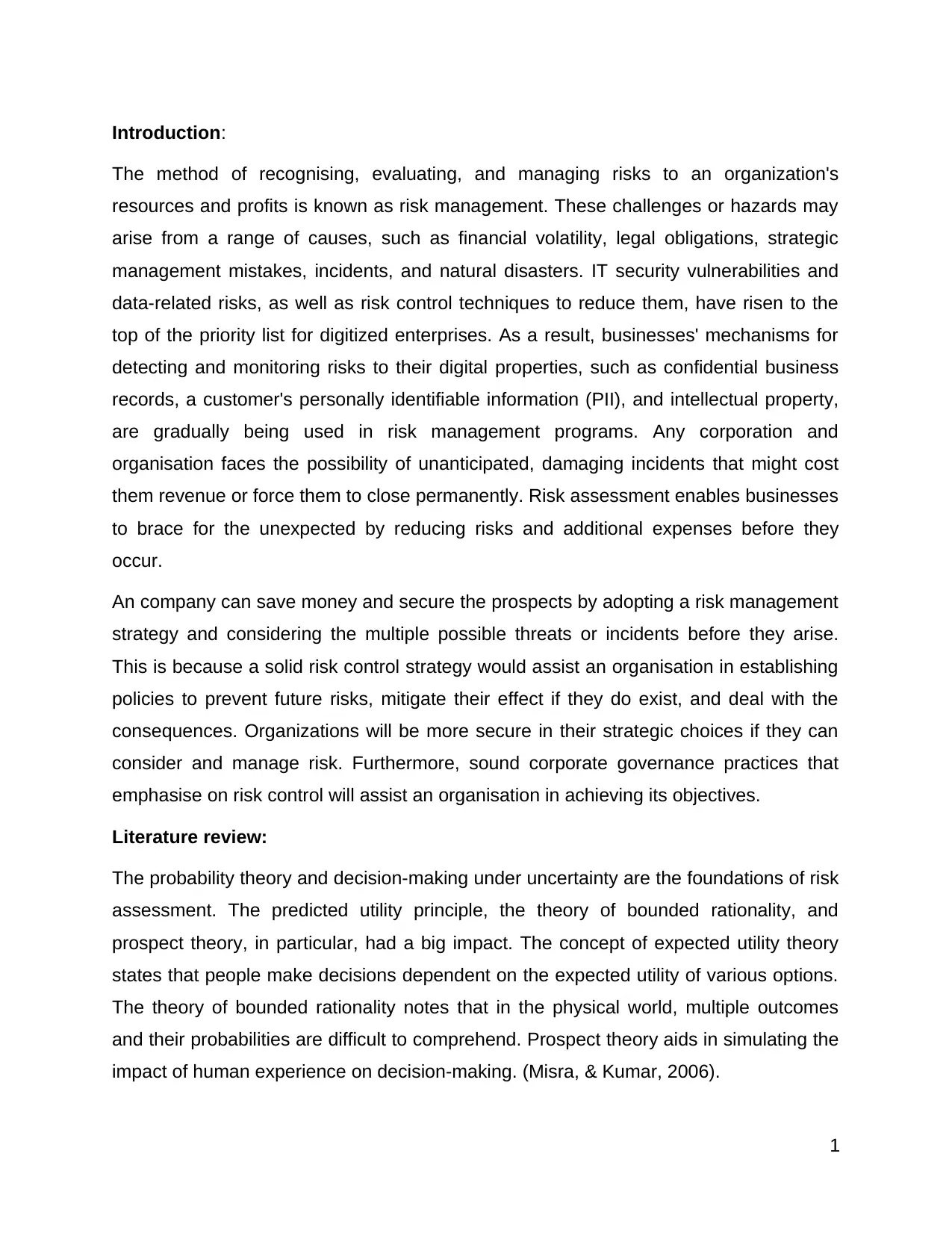
Introduction:
The method of recognising, evaluating, and managing risks to an organization's
resources and profits is known as risk management. These challenges or hazards may
arise from a range of causes, such as financial volatility, legal obligations, strategic
management mistakes, incidents, and natural disasters. IT security vulnerabilities and
data-related risks, as well as risk control techniques to reduce them, have risen to the
top of the priority list for digitized enterprises. As a result, businesses' mechanisms for
detecting and monitoring risks to their digital properties, such as confidential business
records, a customer's personally identifiable information (PII), and intellectual property,
are gradually being used in risk management programs. Any corporation and
organisation faces the possibility of unanticipated, damaging incidents that might cost
them revenue or force them to close permanently. Risk assessment enables businesses
to brace for the unexpected by reducing risks and additional expenses before they
occur.
An company can save money and secure the prospects by adopting a risk management
strategy and considering the multiple possible threats or incidents before they arise.
This is because a solid risk control strategy would assist an organisation in establishing
policies to prevent future risks, mitigate their effect if they do exist, and deal with the
consequences. Organizations will be more secure in their strategic choices if they can
consider and manage risk. Furthermore, sound corporate governance practices that
emphasise on risk control will assist an organisation in achieving its objectives.
Literature review:
The probability theory and decision-making under uncertainty are the foundations of risk
assessment. The predicted utility principle, the theory of bounded rationality, and
prospect theory, in particular, had a big impact. The concept of expected utility theory
states that people make decisions dependent on the expected utility of various options.
The theory of bounded rationality notes that in the physical world, multiple outcomes
and their probabilities are difficult to comprehend. Prospect theory aids in simulating the
impact of human experience on decision-making. (Misra, & Kumar, 2006).
1
The method of recognising, evaluating, and managing risks to an organization's
resources and profits is known as risk management. These challenges or hazards may
arise from a range of causes, such as financial volatility, legal obligations, strategic
management mistakes, incidents, and natural disasters. IT security vulnerabilities and
data-related risks, as well as risk control techniques to reduce them, have risen to the
top of the priority list for digitized enterprises. As a result, businesses' mechanisms for
detecting and monitoring risks to their digital properties, such as confidential business
records, a customer's personally identifiable information (PII), and intellectual property,
are gradually being used in risk management programs. Any corporation and
organisation faces the possibility of unanticipated, damaging incidents that might cost
them revenue or force them to close permanently. Risk assessment enables businesses
to brace for the unexpected by reducing risks and additional expenses before they
occur.
An company can save money and secure the prospects by adopting a risk management
strategy and considering the multiple possible threats or incidents before they arise.
This is because a solid risk control strategy would assist an organisation in establishing
policies to prevent future risks, mitigate their effect if they do exist, and deal with the
consequences. Organizations will be more secure in their strategic choices if they can
consider and manage risk. Furthermore, sound corporate governance practices that
emphasise on risk control will assist an organisation in achieving its objectives.
Literature review:
The probability theory and decision-making under uncertainty are the foundations of risk
assessment. The predicted utility principle, the theory of bounded rationality, and
prospect theory, in particular, had a big impact. The concept of expected utility theory
states that people make decisions dependent on the expected utility of various options.
The theory of bounded rationality notes that in the physical world, multiple outcomes
and their probabilities are difficult to comprehend. Prospect theory aids in simulating the
impact of human experience on decision-making. (Misra, & Kumar, 2006).
1
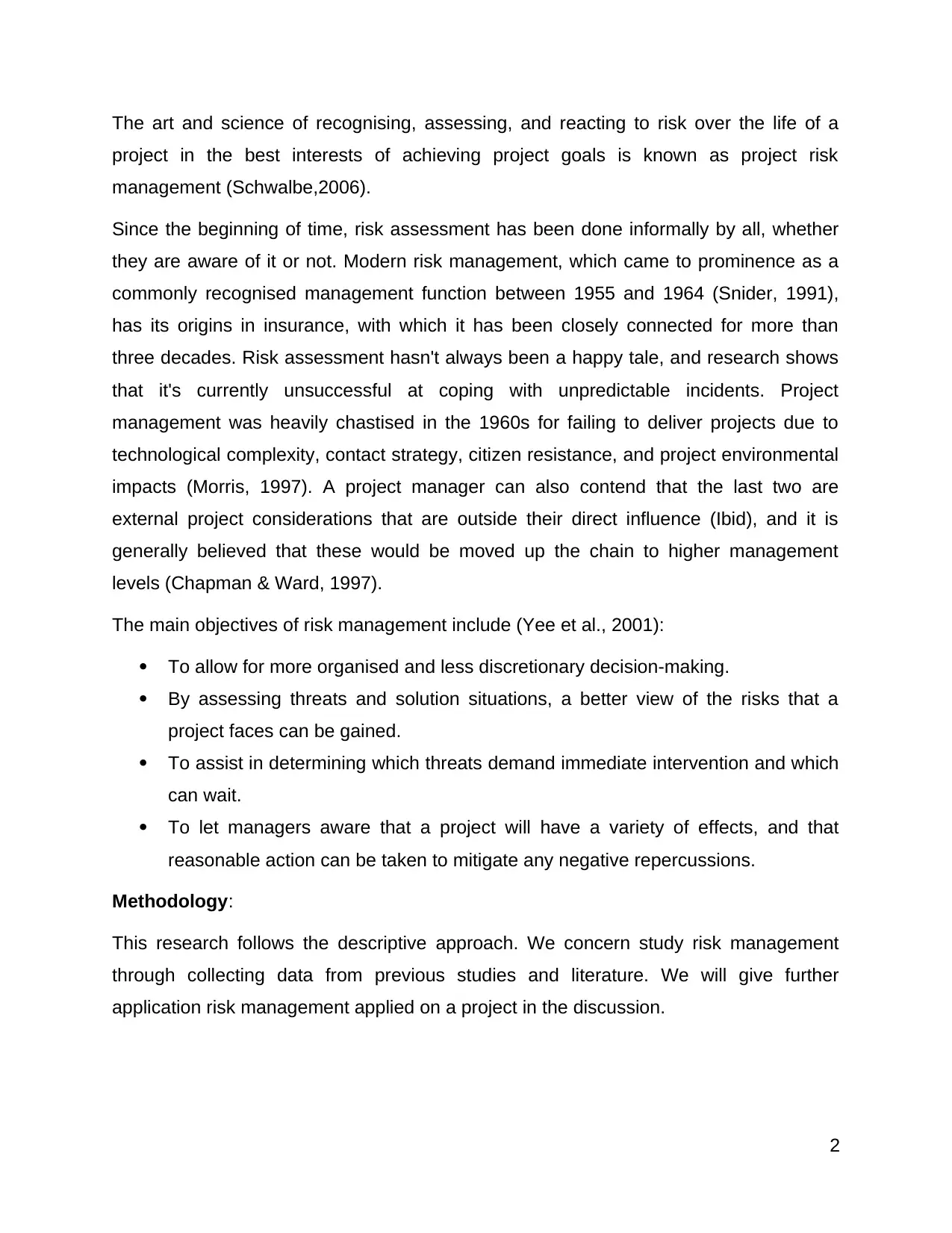
The art and science of recognising, assessing, and reacting to risk over the life of a
project in the best interests of achieving project goals is known as project risk
management (Schwalbe,2006).
Since the beginning of time, risk assessment has been done informally by all, whether
they are aware of it or not. Modern risk management, which came to prominence as a
commonly recognised management function between 1955 and 1964 (Snider, 1991),
has its origins in insurance, with which it has been closely connected for more than
three decades. Risk assessment hasn't always been a happy tale, and research shows
that it's currently unsuccessful at coping with unpredictable incidents. Project
management was heavily chastised in the 1960s for failing to deliver projects due to
technological complexity, contact strategy, citizen resistance, and project environmental
impacts (Morris, 1997). A project manager can also contend that the last two are
external project considerations that are outside their direct influence (Ibid), and it is
generally believed that these would be moved up the chain to higher management
levels (Chapman & Ward, 1997).
The main objectives of risk management include (Yee et al., 2001):
To allow for more organised and less discretionary decision-making.
By assessing threats and solution situations, a better view of the risks that a
project faces can be gained.
To assist in determining which threats demand immediate intervention and which
can wait.
To let managers aware that a project will have a variety of effects, and that
reasonable action can be taken to mitigate any negative repercussions.
Methodology:
This research follows the descriptive approach. We concern study risk management
through collecting data from previous studies and literature. We will give further
application risk management applied on a project in the discussion.
2
project in the best interests of achieving project goals is known as project risk
management (Schwalbe,2006).
Since the beginning of time, risk assessment has been done informally by all, whether
they are aware of it or not. Modern risk management, which came to prominence as a
commonly recognised management function between 1955 and 1964 (Snider, 1991),
has its origins in insurance, with which it has been closely connected for more than
three decades. Risk assessment hasn't always been a happy tale, and research shows
that it's currently unsuccessful at coping with unpredictable incidents. Project
management was heavily chastised in the 1960s for failing to deliver projects due to
technological complexity, contact strategy, citizen resistance, and project environmental
impacts (Morris, 1997). A project manager can also contend that the last two are
external project considerations that are outside their direct influence (Ibid), and it is
generally believed that these would be moved up the chain to higher management
levels (Chapman & Ward, 1997).
The main objectives of risk management include (Yee et al., 2001):
To allow for more organised and less discretionary decision-making.
By assessing threats and solution situations, a better view of the risks that a
project faces can be gained.
To assist in determining which threats demand immediate intervention and which
can wait.
To let managers aware that a project will have a variety of effects, and that
reasonable action can be taken to mitigate any negative repercussions.
Methodology:
This research follows the descriptive approach. We concern study risk management
through collecting data from previous studies and literature. We will give further
application risk management applied on a project in the discussion.
2
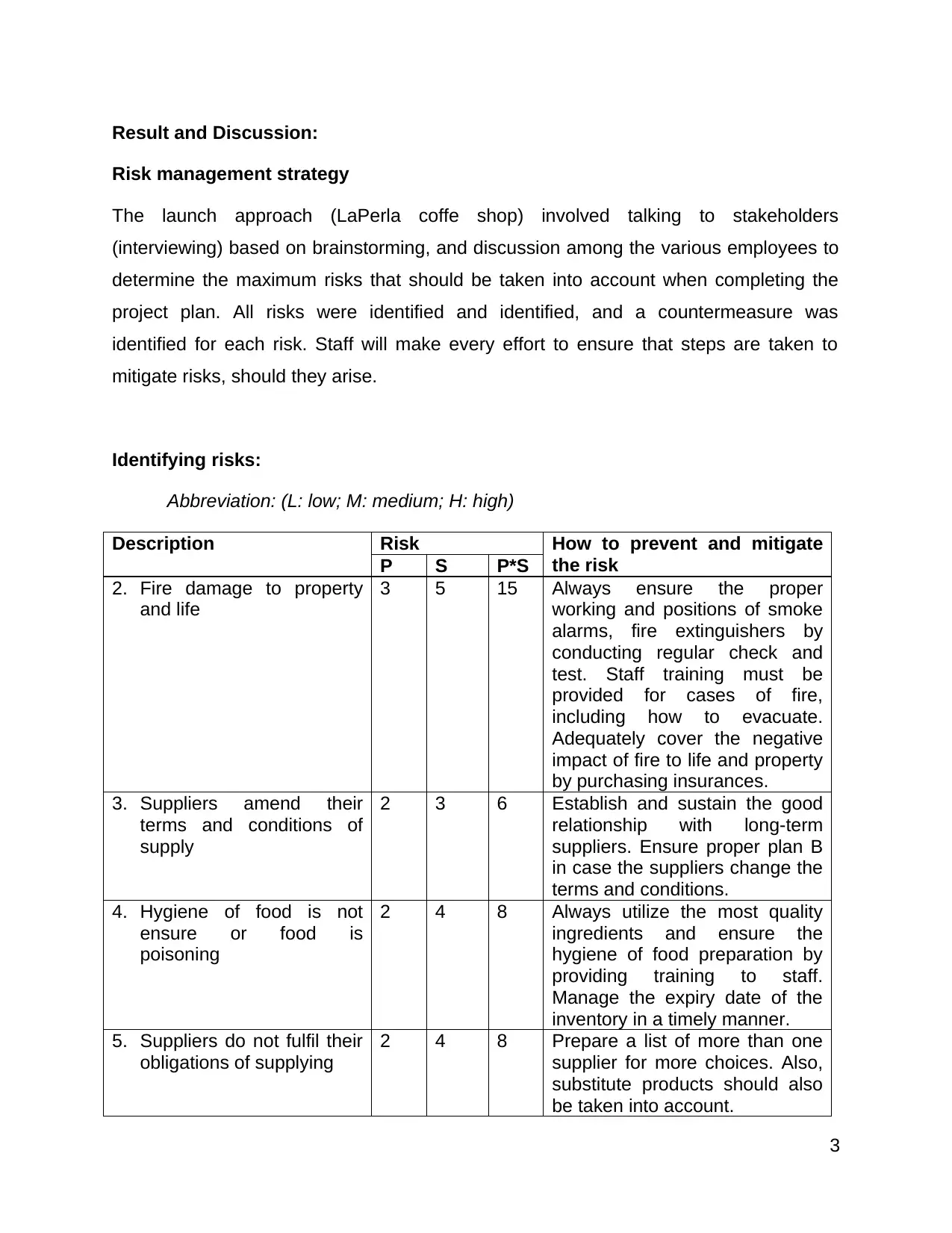
Result and Discussion:
Risk management strategy
The launch approach (LaPerla coffe shop) involved talking to stakeholders
(interviewing) based on brainstorming, and discussion among the various employees to
determine the maximum risks that should be taken into account when completing the
project plan. All risks were identified and identified, and a countermeasure was
identified for each risk. Staff will make every effort to ensure that steps are taken to
mitigate risks, should they arise.
Identifying risks:
Abbreviation: (L: low; M: medium; H: high)
Description Risk How to prevent and mitigate
the riskP S P*S
2. Fire damage to property
and life
3 5 15 Always ensure the proper
working and positions of smoke
alarms, fire extinguishers by
conducting regular check and
test. Staff training must be
provided for cases of fire,
including how to evacuate.
Adequately cover the negative
impact of fire to life and property
by purchasing insurances.
3. Suppliers amend their
terms and conditions of
supply
2 3 6 Establish and sustain the good
relationship with long-term
suppliers. Ensure proper plan B
in case the suppliers change the
terms and conditions.
4. Hygiene of food is not
ensure or food is
poisoning
2 4 8 Always utilize the most quality
ingredients and ensure the
hygiene of food preparation by
providing training to staff.
Manage the expiry date of the
inventory in a timely manner.
5. Suppliers do not fulfil their
obligations of supplying
2 4 8 Prepare a list of more than one
supplier for more choices. Also,
substitute products should also
be taken into account.
3
Risk management strategy
The launch approach (LaPerla coffe shop) involved talking to stakeholders
(interviewing) based on brainstorming, and discussion among the various employees to
determine the maximum risks that should be taken into account when completing the
project plan. All risks were identified and identified, and a countermeasure was
identified for each risk. Staff will make every effort to ensure that steps are taken to
mitigate risks, should they arise.
Identifying risks:
Abbreviation: (L: low; M: medium; H: high)
Description Risk How to prevent and mitigate
the riskP S P*S
2. Fire damage to property
and life
3 5 15 Always ensure the proper
working and positions of smoke
alarms, fire extinguishers by
conducting regular check and
test. Staff training must be
provided for cases of fire,
including how to evacuate.
Adequately cover the negative
impact of fire to life and property
by purchasing insurances.
3. Suppliers amend their
terms and conditions of
supply
2 3 6 Establish and sustain the good
relationship with long-term
suppliers. Ensure proper plan B
in case the suppliers change the
terms and conditions.
4. Hygiene of food is not
ensure or food is
poisoning
2 4 8 Always utilize the most quality
ingredients and ensure the
hygiene of food preparation by
providing training to staff.
Manage the expiry date of the
inventory in a timely manner.
5. Suppliers do not fulfil their
obligations of supplying
2 4 8 Prepare a list of more than one
supplier for more choices. Also,
substitute products should also
be taken into account.
3
Secure Best Marks with AI Grader
Need help grading? Try our AI Grader for instant feedback on your assignments.
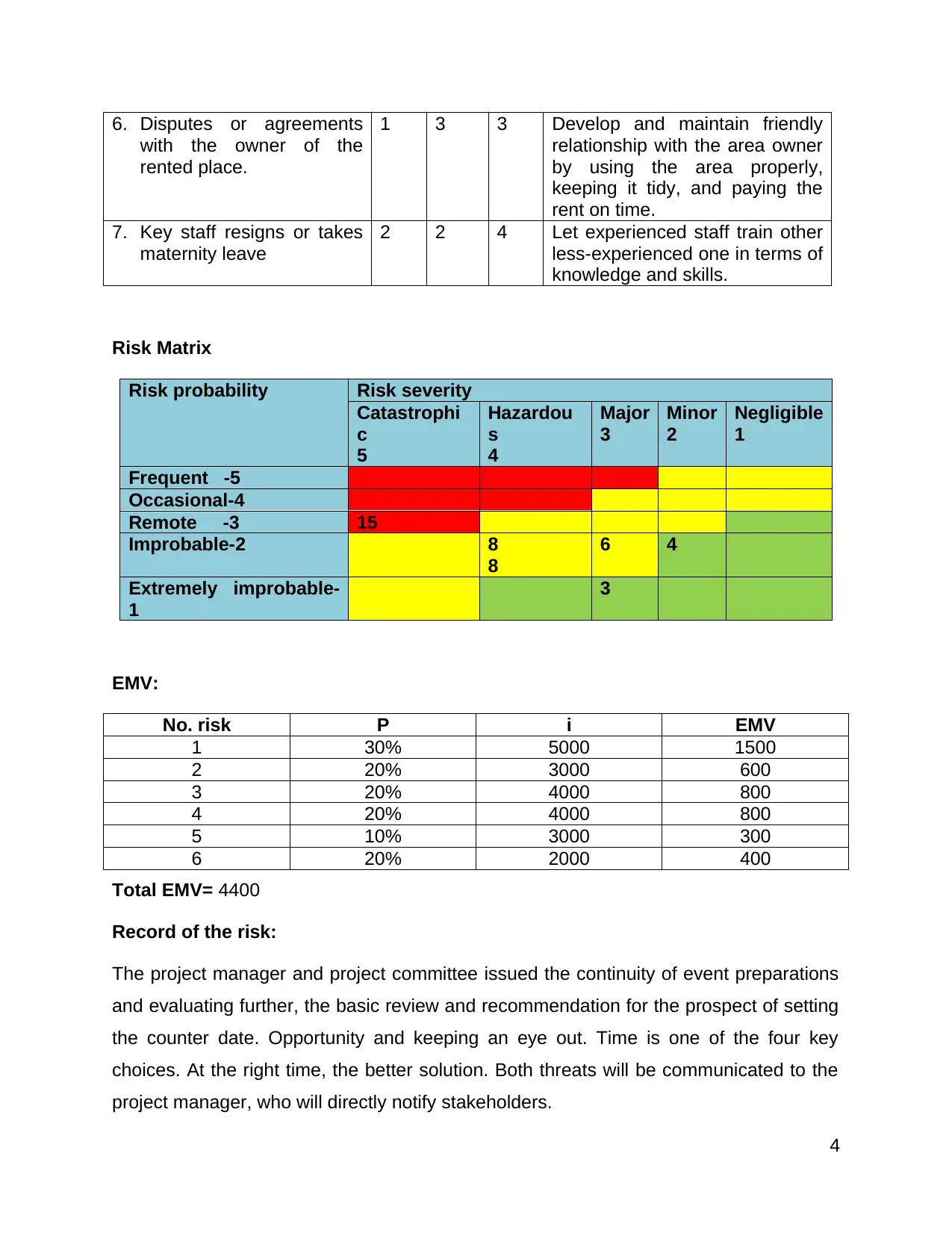
6. Disputes or agreements
with the owner of the
rented place.
1 3 3 Develop and maintain friendly
relationship with the area owner
by using the area properly,
keeping it tidy, and paying the
rent on time.
7. Key staff resigns or takes
maternity leave
2 2 4 Let experienced staff train other
less-experienced one in terms of
knowledge and skills.
Risk Matrix
Risk probability Risk severity
Catastrophi
c
5
Hazardou
s
4
Major
3
Minor
2
Negligible
1
Frequent -5
Occasional-4
Remote -3 15
Improbable-2 8
8
6 4
Extremely improbable-
1
3
EMV:
No. risk P i EMV
1 30% 5000 1500
2 20% 3000 600
3 20% 4000 800
4 20% 4000 800
5 10% 3000 300
6 20% 2000 400
Total EMV= 4400
Record of the risk:
The project manager and project committee issued the continuity of event preparations
and evaluating further, the basic review and recommendation for the prospect of setting
the counter date. Opportunity and keeping an eye out. Time is one of the four key
choices. At the right time, the better solution. Both threats will be communicated to the
project manager, who will directly notify stakeholders.
4
with the owner of the
rented place.
1 3 3 Develop and maintain friendly
relationship with the area owner
by using the area properly,
keeping it tidy, and paying the
rent on time.
7. Key staff resigns or takes
maternity leave
2 2 4 Let experienced staff train other
less-experienced one in terms of
knowledge and skills.
Risk Matrix
Risk probability Risk severity
Catastrophi
c
5
Hazardou
s
4
Major
3
Minor
2
Negligible
1
Frequent -5
Occasional-4
Remote -3 15
Improbable-2 8
8
6 4
Extremely improbable-
1
3
EMV:
No. risk P i EMV
1 30% 5000 1500
2 20% 3000 600
3 20% 4000 800
4 20% 4000 800
5 10% 3000 300
6 20% 2000 400
Total EMV= 4400
Record of the risk:
The project manager and project committee issued the continuity of event preparations
and evaluating further, the basic review and recommendation for the prospect of setting
the counter date. Opportunity and keeping an eye out. Time is one of the four key
choices. At the right time, the better solution. Both threats will be communicated to the
project manager, who will directly notify stakeholders.
4
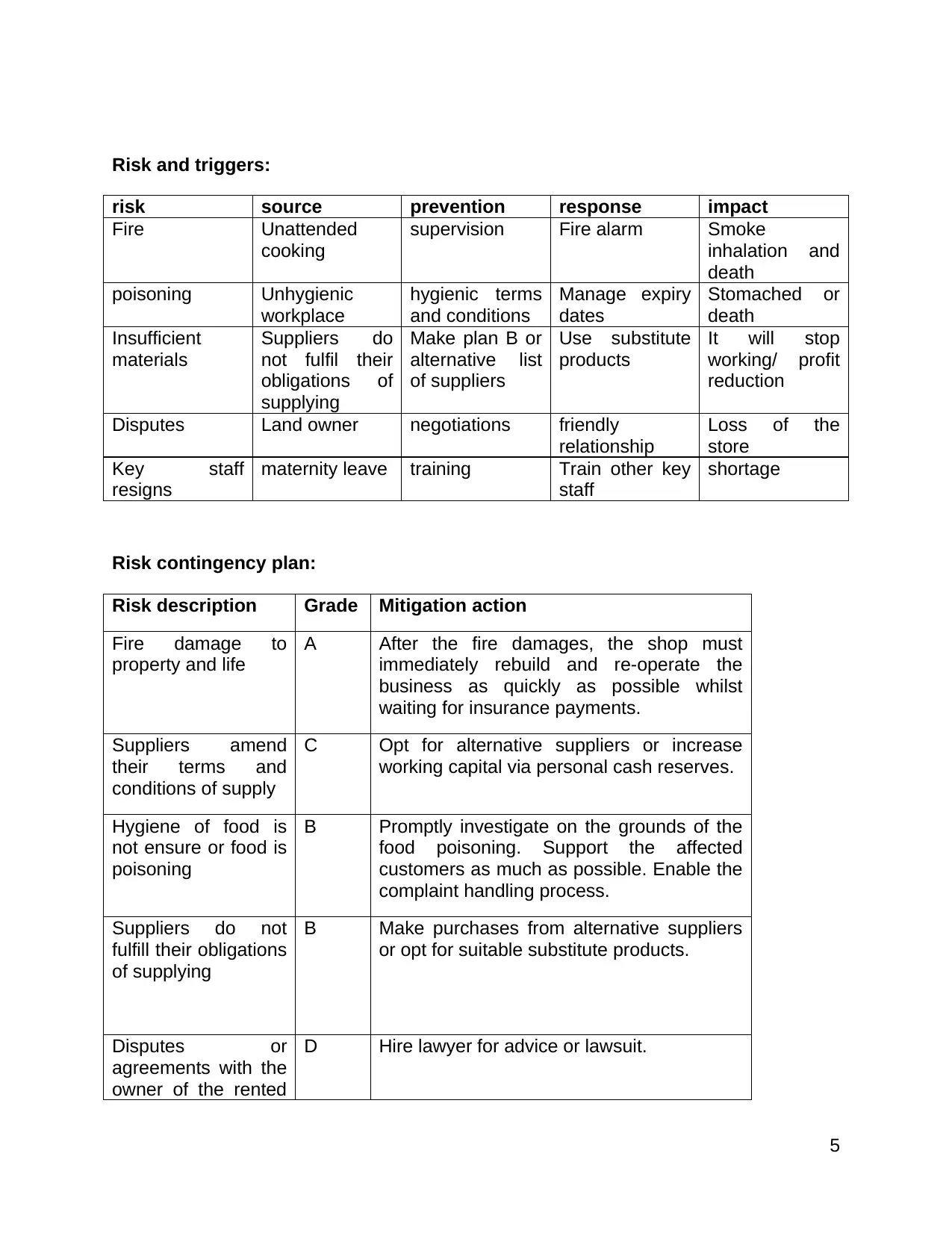
Risk and triggers:
risk source prevention response impact
Fire Unattended
cooking
supervision Fire alarm Smoke
inhalation and
death
poisoning Unhygienic
workplace
hygienic terms
and conditions
Manage expiry
dates
Stomached or
death
Insufficient
materials
Suppliers do
not fulfil their
obligations of
supplying
Make plan B or
alternative list
of suppliers
Use substitute
products
It will stop
working/ profit
reduction
Disputes Land owner negotiations friendly
relationship
Loss of the
store
Key staff
resigns
maternity leave training Train other key
staff
shortage
Risk contingency plan:
Risk description Grade Mitigation action
Fire damage to
property and life
A After the fire damages, the shop must
immediately rebuild and re-operate the
business as quickly as possible whilst
waiting for insurance payments.
Suppliers amend
their terms and
conditions of supply
C Opt for alternative suppliers or increase
working capital via personal cash reserves.
Hygiene of food is
not ensure or food is
poisoning
B Promptly investigate on the grounds of the
food poisoning. Support the affected
customers as much as possible. Enable the
complaint handling process.
Suppliers do not
fulfill their obligations
of supplying
B Make purchases from alternative suppliers
or opt for suitable substitute products.
Disputes or
agreements with the
owner of the rented
D Hire lawyer for advice or lawsuit.
5
risk source prevention response impact
Fire Unattended
cooking
supervision Fire alarm Smoke
inhalation and
death
poisoning Unhygienic
workplace
hygienic terms
and conditions
Manage expiry
dates
Stomached or
death
Insufficient
materials
Suppliers do
not fulfil their
obligations of
supplying
Make plan B or
alternative list
of suppliers
Use substitute
products
It will stop
working/ profit
reduction
Disputes Land owner negotiations friendly
relationship
Loss of the
store
Key staff
resigns
maternity leave training Train other key
staff
shortage
Risk contingency plan:
Risk description Grade Mitigation action
Fire damage to
property and life
A After the fire damages, the shop must
immediately rebuild and re-operate the
business as quickly as possible whilst
waiting for insurance payments.
Suppliers amend
their terms and
conditions of supply
C Opt for alternative suppliers or increase
working capital via personal cash reserves.
Hygiene of food is
not ensure or food is
poisoning
B Promptly investigate on the grounds of the
food poisoning. Support the affected
customers as much as possible. Enable the
complaint handling process.
Suppliers do not
fulfill their obligations
of supplying
B Make purchases from alternative suppliers
or opt for suitable substitute products.
Disputes or
agreements with the
owner of the rented
D Hire lawyer for advice or lawsuit.
5
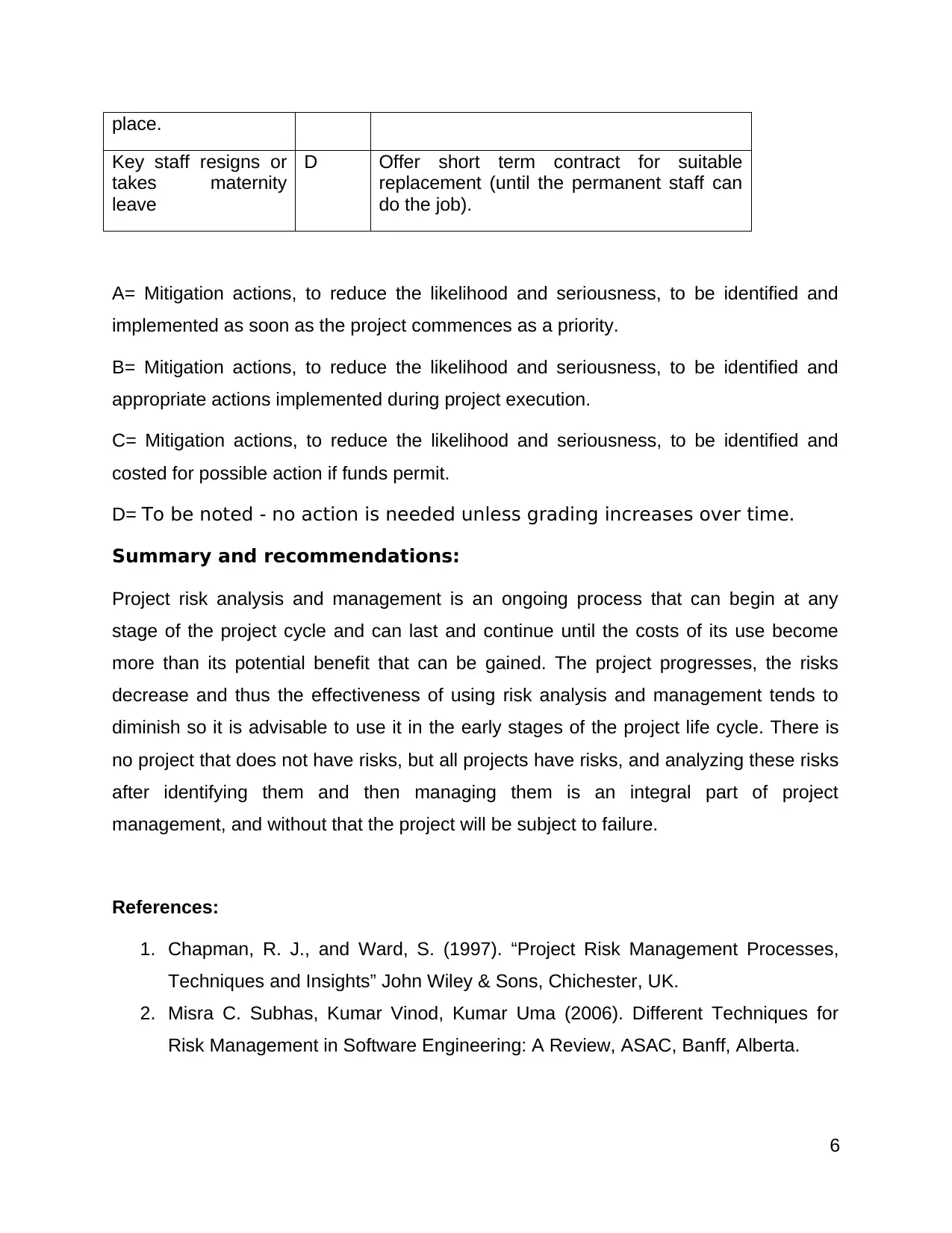
place.
Key staff resigns or
takes maternity
leave
D Offer short term contract for suitable
replacement (until the permanent staff can
do the job).
A= Mitigation actions, to reduce the likelihood and seriousness, to be identified and
implemented as soon as the project commences as a priority.
B= Mitigation actions, to reduce the likelihood and seriousness, to be identified and
appropriate actions implemented during project execution.
C= Mitigation actions, to reduce the likelihood and seriousness, to be identified and
costed for possible action if funds permit.
D= To be noted - no action is needed unless grading increases over time.
Summary and recommendations:
Project risk analysis and management is an ongoing process that can begin at any
stage of the project cycle and can last and continue until the costs of its use become
more than its potential benefit that can be gained. The project progresses, the risks
decrease and thus the effectiveness of using risk analysis and management tends to
diminish so it is advisable to use it in the early stages of the project life cycle. There is
no project that does not have risks, but all projects have risks, and analyzing these risks
after identifying them and then managing them is an integral part of project
management, and without that the project will be subject to failure.
References:
1. Chapman, R. J., and Ward, S. (1997). “Project Risk Management Processes,
Techniques and Insights” John Wiley & Sons, Chichester, UK.
2. Misra C. Subhas, Kumar Vinod, Kumar Uma (2006). Different Techniques for
Risk Management in Software Engineering: A Review, ASAC, Banff, Alberta.
6
Key staff resigns or
takes maternity
leave
D Offer short term contract for suitable
replacement (until the permanent staff can
do the job).
A= Mitigation actions, to reduce the likelihood and seriousness, to be identified and
implemented as soon as the project commences as a priority.
B= Mitigation actions, to reduce the likelihood and seriousness, to be identified and
appropriate actions implemented during project execution.
C= Mitigation actions, to reduce the likelihood and seriousness, to be identified and
costed for possible action if funds permit.
D= To be noted - no action is needed unless grading increases over time.
Summary and recommendations:
Project risk analysis and management is an ongoing process that can begin at any
stage of the project cycle and can last and continue until the costs of its use become
more than its potential benefit that can be gained. The project progresses, the risks
decrease and thus the effectiveness of using risk analysis and management tends to
diminish so it is advisable to use it in the early stages of the project life cycle. There is
no project that does not have risks, but all projects have risks, and analyzing these risks
after identifying them and then managing them is an integral part of project
management, and without that the project will be subject to failure.
References:
1. Chapman, R. J., and Ward, S. (1997). “Project Risk Management Processes,
Techniques and Insights” John Wiley & Sons, Chichester, UK.
2. Misra C. Subhas, Kumar Vinod, Kumar Uma (2006). Different Techniques for
Risk Management in Software Engineering: A Review, ASAC, Banff, Alberta.
6
Paraphrase This Document
Need a fresh take? Get an instant paraphrase of this document with our AI Paraphraser
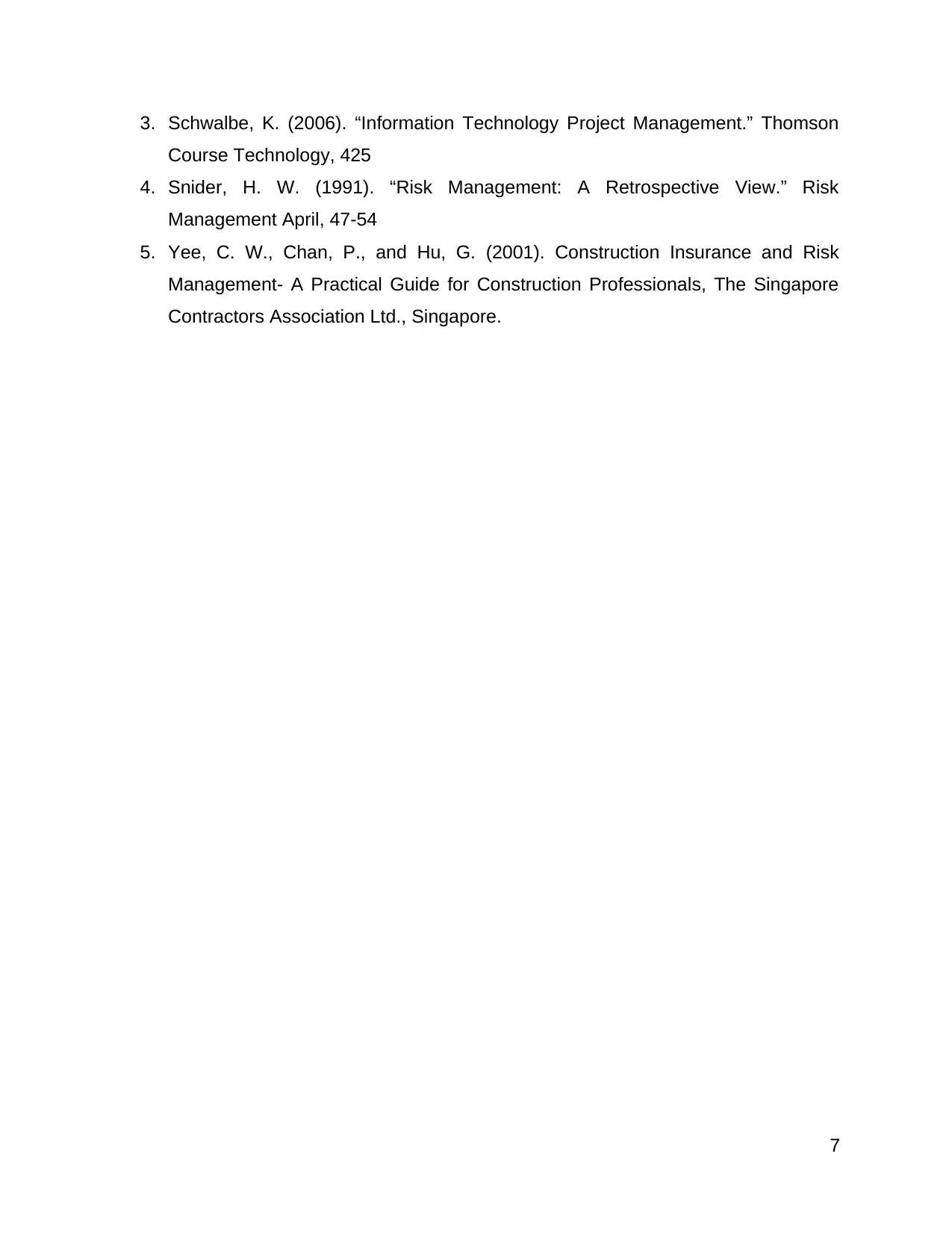
3. Schwalbe, K. (2006). “Information Technology Project Management.” Thomson
Course Technology, 425
4. Snider, H. W. (1991). “Risk Management: A Retrospective View.” Risk
Management April, 47-54
5. Yee, C. W., Chan, P., and Hu, G. (2001). Construction Insurance and Risk
Management- A Practical Guide for Construction Professionals, The Singapore
Contractors Association Ltd., Singapore.
7
Course Technology, 425
4. Snider, H. W. (1991). “Risk Management: A Retrospective View.” Risk
Management April, 47-54
5. Yee, C. W., Chan, P., and Hu, G. (2001). Construction Insurance and Risk
Management- A Practical Guide for Construction Professionals, The Singapore
Contractors Association Ltd., Singapore.
7
1 out of 8
Your All-in-One AI-Powered Toolkit for Academic Success.
+13062052269
info@desklib.com
Available 24*7 on WhatsApp / Email
![[object Object]](/_next/static/media/star-bottom.7253800d.svg)
Unlock your academic potential
© 2024 | Zucol Services PVT LTD | All rights reserved.